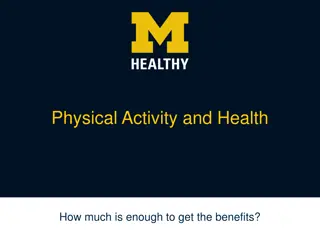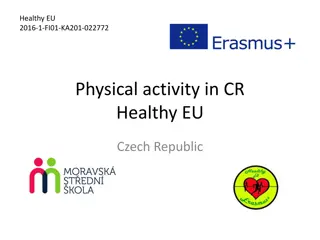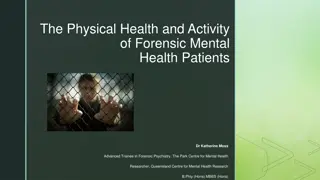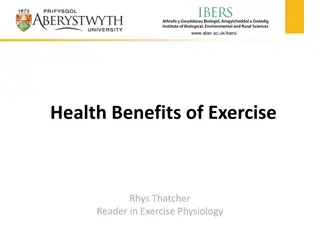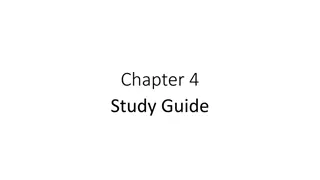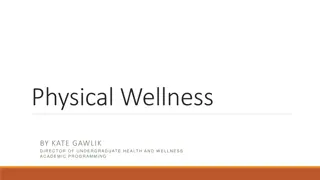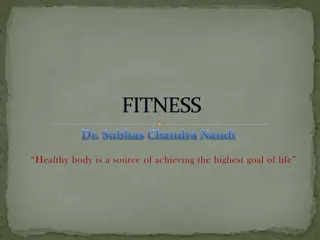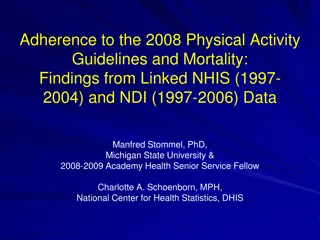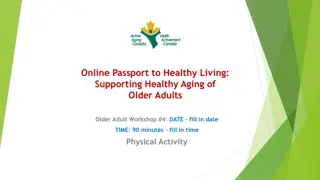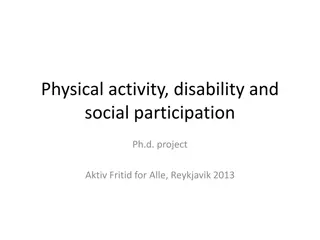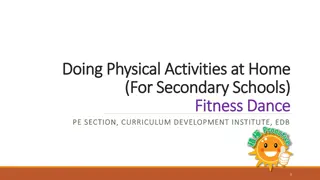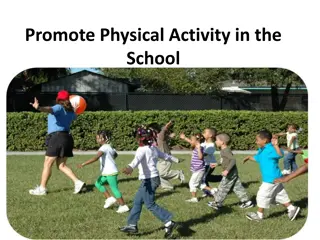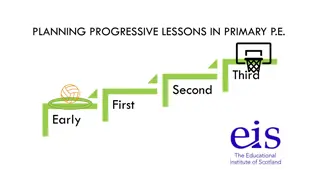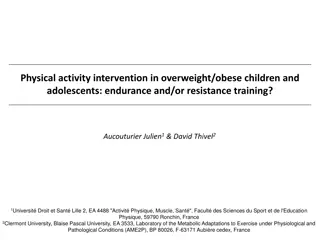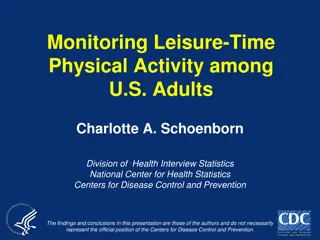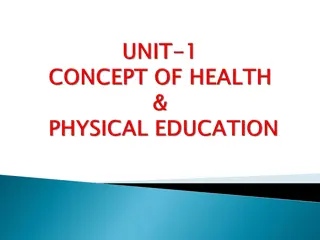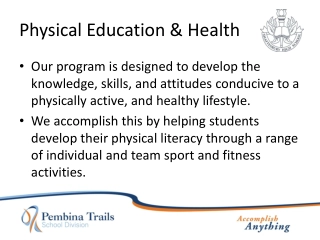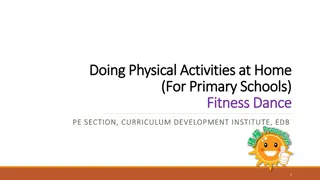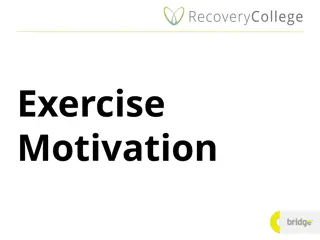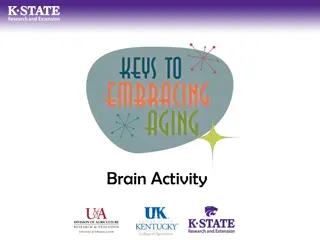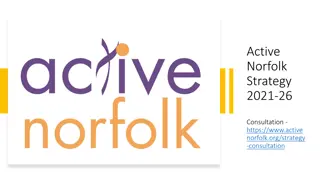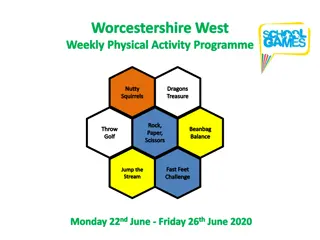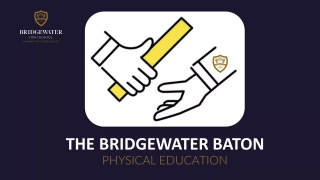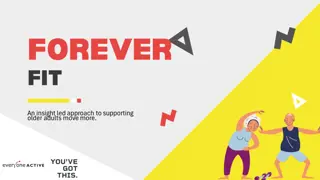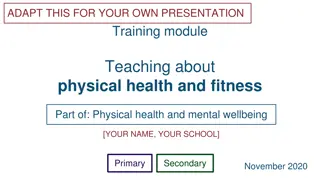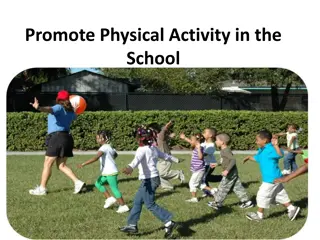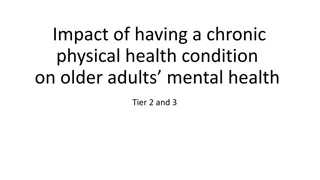Benefits of Physical Activity: Enhancing Your Health Inside and Out
Physical activity offers a multitude of benefits for your overall well-being, including strengthening muscles and bones, boosting energy levels, improving cardiovascular and respiratory systems, enhancing mental and emotional health through stress relief and mood enhancement, and fostering social connections. Engaging in regular physical activity can lead to a healthier body, a happier mind, and stronger social relationships.
Download Presentation

Please find below an Image/Link to download the presentation.
The content on the website is provided AS IS for your information and personal use only. It may not be sold, licensed, or shared on other websites without obtaining consent from the author. Download presentation by click this link. If you encounter any issues during the download, it is possible that the publisher has removed the file from their server.
E N D
Presentation Transcript
PHYSICAL ACTIVITY AND FITNESS PHYSICAL ACTIVITY AND FITNESS
Benefits of Physical Activity Physical Activity: any form of movement that causes your body to use energy. Walking to school, cleaning your room, yardwork, or playing sports with your friends all count as physical activity Physical Fitness: the ability to carry out daily tasks easily and have enough reserve energy to respond to unexpected demands. Recommended daily physical activity for teens is 60 minutes. Exercise: purposeful physical activity that is planned, structured, and repetitive, and that improves or maintains physical fitness. Help in achieving specific fitness goals Physical activity benefits all aspects of your health physical, mental/emotional, and social health
Physical Benefits Strengthen your muscles and bones Boost your energy level Improve your posture Maintain a healthy weight Reduce your risk of many serious diseases
Physical Benefits Body Systems Cardiovascular System: strengthens the heart muscle so that it pumps blood more efficiently. It reduces blood pressure & lowers the levels of artery-clogging cholesterol. Respiratory System: lungs begin to work more efficiently, pulling in larger amounts of air & increasing the amount of oxygen delivered to your body. Allowing you to do many activities more easily (running a greater distance without becoming short of breath). Musculoskeletal System: strengthens muscles & bones, reducing your risk of developing fragile bones as you age. Strengthening your bones and muscles can also improve your balance & coordination.
Mental and Emotional Benefits Stress Relief Physical activity stimulates the body to produce chemicals called endorphins. Results in a feeling of well-being, aids relaxation, and relieves physical pain. Mood Enhancement Physical activity is a natural mood lifter. Production of endorphins and other brain chemicals that combat anxiety and depression. Better Sleep Moderate activity at least 3 hours before bedtime helps you relax & get to sleep more easily. Improved Self-Esteem Can give you a sense of accomplishment and also help you look and feel your best.
Social Benefits Make new friends Spend time with friends you already have Improve sportsmanship and teamwork Confidence in meeting new people or dealing with social situations Manage stress to prevent build up that could have a negative impact on relationships
Bell Ringer Word Bank (1st4 questions) Physical Fitness Exercise Physical Activity Sedentary 1. Any form of movement that causes your body to use energy. 2. A lifestyle that involves little to no physical activity 3. A purposeful activity that is planned, structured, & repetitive, & which improves or maintains physical fitness 4. The ability to carry out daily tasks easily & have enough energy to respond to unexpected demands 5. List 1 benefit of physical activity for the following: Physical Mental and Emotional Social
Risks of Being Inactive An inactive lifestyle puts you at risk for a variety of health problems. Sedentary: involving little physical activity. Watching TV, playing video games, surfing the internet or social media.
Risks of Being Inactive Health problems associated with sedentary lifestyle Unhealthful weight gain and obesity oInactivity and Obesity in Middle School Children https://www.youtube.com/watch?v=9KWPCEUIKbU&t=210s&index=2&list=WL oThe Skinny on Obesity (Ep 1): An Epidemic for Every Body https://www.youtube.com/watch?v=h0zD1gj0pXk&list=WL&index=1 Cardiovascular disease oHeart attack: oxygen cuts off to heart causing tissue damage oStroke: oxygen cuts off to the brain causing tissue damage
Risks of Being Inactive Health Problems continued Type II Diabetes oDifference between Type I Diabetes Certain types of cancer Asthma & other breathing problems Osteoporosis: bones become porous & fragile, making them easier to break Osteoarthritis: breakdown of cartilage & bone in the body s joints Psychological problems: stress, anxiety, & depression Premature death
Making Time for Physical Activity Spreading 60 minutes over shorter periods of activity 10 minutes of physical activity, six times a day Instead of this Try this Taking the elevator Taking the stairs Getting a ride to school or a friend s house Walking, skating, or riding your bike Using a shopping cart Carrying your groceries to the car Taking the car through a car wash Washing the car by hand Parking closer to the entrance Parking farther away from the entrance and walking Playing video or computer games Playing basketball, soccer, or tennis Facing the Real Issues: Physical Activity https://www.youtube.com/watch?v=g6J05QHC26Y&list=WL&index=3
Improving Your Fitness Elements (Components) of Fitness Cardiorespiratory endurance: ability of your heart, lungs, and blood vessels to send fuel and oxygen to your tissues during long periods of moderate to vigorous activity. o Running a mile or going for a hike without tiring Muscular strength: amount of force your muscles can exert. o Activities that put stress on your muscles include lifting, pushing, and jumping Muscular endurance: ability of your muscles to perform physical tasks over a period of time without tiring. o Carrying boxes up and down a flight of stairs or holding a plank Flexibility: ability to move your body parts through their full range of motion. o Touching your toes without bending your legs or putting sunscreen on the center of your back. Flexibility can improve athletic performance and reduce your risk of muscle strain and other injuries. Body composition: the ratio of fat to lean tissue in your body. o Having low overall body fat reduces the risk of cardiovascular disease and other health problems associated with being overweight or obese.
Getting Fit Two categories for different forms of exercise Aerobic (oxygen use): all rhythmic activities that use large muscle groups for an extended period of time. Raises heart rate & increases your body s use of oxygen. Jogging, swimming, and riding a bike. Anaerobic (no oxygen use): intense short bursts of activity in which the muscles work so hard that they produce energy without using oxygen. Sprinting and lifting weights. Improving Cardiorespiratory Endurance Aerobic exercise: increase heart rate and pump more blood throughout your body Reduces the risk for cardiovascular disease, type II diabetes, certain cancers, and other diseases associated with weight gain. Examples: Step Aerobics, Crossfit, Dancing, Kickboxing, Sports (basketball, football, tennis)
Getting Fit Improving Muscular Strength and Endurance Resistance or strength training Isometric exercises: use muscle tension to improve strength with little or no movement of the body part. Pushing against a wall or other immoveable object; holding a plank. Isotonic exercises: combine movement of the joints with contraction of the muscles. Lifting free weights or doing calisthenics (pull-ups, push-ups, sit-ups). Isokinetic exercises: exert resistance against a muscle as it moves through a range of motion at a steady rate of speed. The use of weight machines and other exercise equipment. Increasing muscle mass boosts your metabolism so your body burns the energy you consume faster, even at rest.
Getting Fit Improving Flexibility Stretching exercises improve your flexibility, circulation, posture, and coordination, as well as ease stress. Reduce the risk of injury during other activities. Exercise and Bone Strength Exercise helps increase bone density and lowers the risk of osteoporosis. Weight-bearing exercises work with gravity and are good for strengthening bones. Walking, strength training, aerobics, and dancing.
Calculating Heart Rate and Target Heart Zones See Handout
Weight Training Introduction Acceptable Conduct No touching equipment without permission and supervision Dress appropriately for the activity Keep from making excess noise and horseplay No eating or drinking Do not distract anyone while they are working out No messing around in the weight room Do not bang or drop weights. If too heavy grab someone to help with the load Return all equipment to it s proper place
Weight Training Introduction General Safety Always follow acceptable conduct rules Always workout with a partner or group Perform only the lifts taught in class and do not lift any heavier then your ability Use proper lifting techniques taught in class If you are using any free weights you must have a spotter Inspect all equipment prior to using and make sure nothing is defective or broken. Make sure collars, clips, and straps are secure Report any broken or damaged equipment immediately
Weight Training Introduction Benefits Improve Strength Improved Muscular Endurance Improved Muscle Size Decreased Body Fat Improved Appearance Improved Self-concept Decreased Fatigue Reduce Chance of Injury Increased Physical Efficiency and Productivity
Weight Training Introduction Spotting Focus full attention on the lifter. Do not look around the room or talk to others while spotting Listen for any pre-lift instructions from the lifter concerning the number or type of exercises to be performed Verbally communicate and coordinate actions with any assisting spotters Assist the lifter in receiving the weight in the proper starting position for the exercise Verbally encourage the lifter during the exercise Give any necessary physical assistance to enable the lifter to complete the desired number of repetitions Assist the lifter in returning the weight to its resting place
WARM-UP ACTIVITY TABATA (20seconds work/ 10seconds rest) 1. CRUNCHES 2. PUSH-UPS 3. SQUAT JUMPS 4. PLANKS 5. MOUNTAIN CLIMBERS 6. TRICEPS DIPS 7. WALL SITS 8. BURPEES Repeat each exercise for another round
LIFT FORM DEMONSTRATION Day 1: Barbell Work Bench Press Dead Lift Clean to Front Squat/ Clean to Back Squat Position Day 2: Resistance Work Dip Bars using Bands for support Battle Ropes Bench Hamstring Curl using Band tethered Day 3: Resistance Equipment Stability Ball (Sit-up, Oblique Crunch, Push-up-hands on ball/feet on ball) Medicine Ball (Russian Twist, Partner Back to Back side pass off) Kettleball Swing
Weight Training Activity Day 1: Students will become familiar with equipment use. They can sample as many exercises as possible in the time frame given. Day 2-5: Alternate between the options below. group should be doing option A one day and then option B the next. They must have an exercise for each body part (5 exercises total). Even if an exercise is total body, they still need 5 total. Option A: Upper Body Option B: Lower Body Repetition: the number of times you can complete an exercise or repetition at a given time. Set: A group of repetitions Shoulder Back Chest Glutes Strength/Muscle Size: Heavy Weight/Low Reps Weight you can lift 3-4 sets with 7-8 reps Endurance/Muscle Tone: Light Weight/High Reps Weight you can lift 3-4 sets with 10-12 reps Biceps Quadriceps (front of thigh) Triceps Hamstrings (back of thigh) Abdominals Calf
Weight Training Activity Option A: Upper Body Option B: Lower Body Repetition: the number of times you can complete an exercise or repetition at a given time. Set: A group of repetitions Shoulder Back Chest Glutes Strength/Muscle Size: Heavy Weight/Low Reps Weight you can lift 3-4 sets with 7-8 reps Endurance/Muscle Tone: Light Weight/High Reps Weight you can lift 3-4 sets with 10-12 reps Biceps Quadriceps (front of thigh) Triceps Hamstrings (back of thigh) Abdominals Calf
PLANNING A PERSONAL ACTIVITY PROGRAM The physical activities you choose depend on factors such as your fitness goals and the activities you like Fitness Goals Use fitness assessment as a starting point for creating goals Use of SMART goals in creating a plan Personal Needs Choose activities you enjoy and can realistically do Factors that affect your activity choices Cost, where you live, your schedule, your fitness level, your overall health, personal safety
PLANNING A PERSONAL ACTIVITY PROGRAM Types of Activities A minimum of 60 minutes of physical activity most days A variety of activities to meet specific fitness goals & prevent boredom Limit sedentary activities Moderate-Intensity Physical Activities Daily does of physical activity Walking, climbing stairs, household chores, yard work
PLANNING A PERSONAL ACTIVITY PROGRAM Types of Activities Aerobic Activities: Raise heart rate Aim for 20 minute sessions each week of vigorous aerobic activity Cycling, brisk walking, running, dancing, in-line skating, cross-country skiing, most team sports Strength Training: develops muscle tone Aim for at least 2-3 sessions per week of 20-30 minutes each, w/ 1 day of rest in between Rowing, cross-country skiing, pull-ups, push-ups, cycling, running, skating, abdominal crunches Flexibility: improve range of motion Stretching for 10-12 minutes a day Gymnastics, martial arts, ballet, Pilates, yoga, stretching (dynamic and static)
PLANNING A PERSONAL ACTIVITY PROGRAM Principles of Building Fitness Effective fitness plans focus on four principles: specificity, overload, progression, & regularity Specificity: choosing the right types of activities to improve a given element of fitness Strength training activities will build muscular strength Overload: exercising at a level that s beyond your regular daily activities Increasing the demands on your body will make it adapt and grow stronger Strength Training: increasing weight load by 2-5lbs Aerobic Activity: increasing the intensity or duration Progression: gradually increasing the demands on your body Working a little harder or longer during each session, and more often during the week 30 day challenges: plank, push-up, squats Regularity: working out on a regular basis Minimum of 3 balanced workouts a week to maintain fitness level Different activities to get 60 minutes a day of PA
PLANNING A PERSONAL ACTIVITY PROGRAM Stages of a Workout An exercise session has 3 stages: warm-up, workout, cool-down Warm-up: gentle cardiovascular activity that prepares the muscles for work Increases blood flow, delivering needed oxygen & fuel to muscles Gradual increase of heart rate and body temperature Choose activities that work the same muscles you are using during the workout session Include stretching: dynamic stretching (movement stretching) is best
PLANNING A PERSONAL ACTIVITY PROGRAM Stages of a Workout Workout: part of an exercise session when you are exercising at your highest peak F.I.T.T. Formula Frequency (how often): minimum of 3 exercise sessions per week Give time for body to rest in between Include a variety of physical activity during the week to get 60 minutes/day Intensity (how hard): push yourself hard enough to create overload Aerobic: exercise within target heart rate range Strength: enough to feel strain in muscles but not pain; Rate of perceived exertion (RPE) Type (specific activity): vary exercises throughout the week to build different elements of fitness Jog Monday and Wednesday; Lift weights Tuesday and Thursday Time (duration-how long): The amount of time you complete an exercise session Cardiovascular fitness: minimum 20 minutes within target heart rate range Strength training: 20-30 minutes Flexibility: minimum of 10-12 minutes per day
PLANNING A PERSONAL ACTIVITY PROGRAM Stages of a Workout Rate of Perceived Exertion (RPE): How hard you feel like your body is working Best used during muscular strength/endurance, and flexibility sessions Target Heart Rate Zone: the range that defines the upper and lower limits of your training intensity Best used during cardiorespiratory activities
PLANNING A PERSONAL ACTIVITY PROGRAM Stages of a Workout Cool-down: low-level activity that prepares your body to return to a resting state Allows heart rate, breathing, and body temperature to return to normal gradually Reduces strain on heart and helps prevent muscle soreness 5-10 minutes of gentle activity Good time for static stretching (stretching while holding a movement; stationary stretching)
PLANNING A PERSONAL ACTIVITY PROGRAM Tracking your progress Track your progress to see how your fitness level increases over time Fitness journal can help you track your progress List all activities, noting how long you work out, how often, and at what level Stick to plan for a minimum of 12 weeks Refer to your goals often, to see how you progress
FITNESS PLAN PROJECT FITNESS PLAN PROJECT SMART GOAL: use fitness assessments Warm-up: minimum of 3 aerobic exercises & 3 dynamic stretches Cool-down: minimum of 1 low intensity aerobic exercise & 5 static stretches Aerobic Routine: complete FITT formula once exercises have been selected Strength Routine: complete FITT formula once exercises have been selected Flexibility Routine: complete FITT formula once exercises have been selected 60 minutes per day plan: Include activities in addition to above routine that you can complete daily


